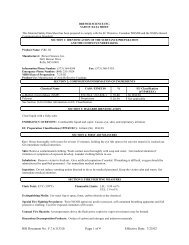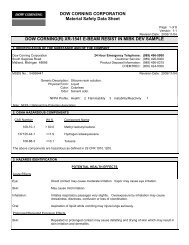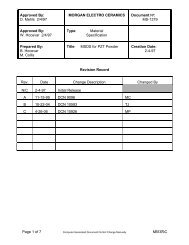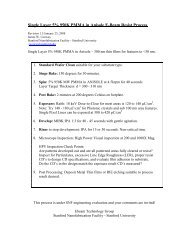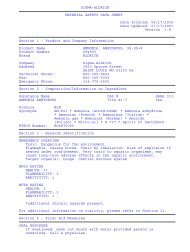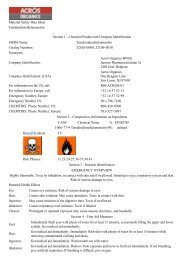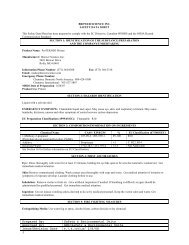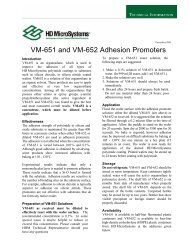MSDS M10 - Stanford Nanofabrication Facility
MSDS M10 - Stanford Nanofabrication Facility
MSDS M10 - Stanford Nanofabrication Facility
You also want an ePaper? Increase the reach of your titles
YUMPU automatically turns print PDFs into web optimized ePapers that Google loves.
Beryllium Solid <strong>MSDS</strong> No. <strong>M10</strong> January 1, 2010<br />
significant loss of lung function. Other symptomatic treatment, such as oxygen, inhaled steroids or<br />
bronchodilators, may be prescribed by some physicians and can be effective in selected cases.<br />
The decision about when and with what medication to treat is a judgment situation for individual physicians.<br />
For the most part, treatment is reserved for those persons with symptoms and measurable loss of lung function.<br />
The value of starting oral steroid treatment, before signs or symptoms are evident, remains a medically<br />
unresolved issue.<br />
The effects of continued low exposure to beryllium are unknown for individuals who are sensitized to<br />
beryllium or who have a diagnosis of chronic beryllium disease. It is generally recommended that persons<br />
who are sensitized to beryllium or who have CBD terminate their occupational exposure to beryllium.<br />
5. FIRE FIGHTING MEASURES<br />
Flash Point Not Applicable to Solids<br />
Explosive Limits Not Applicable to Solids<br />
Extinguishing Media Only in powder or other finely divided form does this material present a<br />
special fire problem. To extinguish a metal powder fire, use Class D<br />
Unusual Fire and Explosion<br />
Hazards<br />
fire extinguishing powder.<br />
Do not use water to extinguish fires around operations involving molten<br />
metal due to the potential for steam explosions. In addition, water may<br />
disassociate when in contact with burning metal particulate or chips<br />
releasing flammable hydrogen gas which could burn and result in an<br />
explosion.<br />
Ventilation duct work which has accumulated a fine coating of this<br />
material as a particulate on its internal surface poses a potentially serious<br />
fire hazard. Extinguish using Class D fire extinguisher media and shut<br />
down or isolate the affected portion of the ventilation system. Because<br />
of this potential risk, sources of ignition such as flame, spark from<br />
machining of other materials, welding spark, etc. must not be allowed to<br />
enter the ventilation duct work. Also, duct work must be made of noncombustible<br />
material. See Section 8 for further information regarding<br />
personal protective measures.<br />
Special Fire Fighting Procedures Pressure-demand self-contained breathing apparatus must be worn by<br />
firefighters or any other persons potentially exposed to the particulate<br />
released during or after a fire.<br />
6. ACCIDENTAL RELEASE MEASURES<br />
STEPS TO BE TAKEN IF MATERIAL IS RELEASED OR SPILLED<br />
If this material is a particulate, establish a restricted entry zone based on the severity of the spill. Persons<br />
entering the restricted zone must wear adequate respiratory protection and protective clothing appropriate for<br />
the severity of the spill (see Section 8). Cleanup spills with a vacuum system utilizing a high efficiency<br />
particulate air (HEPA) filtration system followed by wet cleaning methods. Special precautions must be taken<br />
when changing filters on HEPA vacuum cleaners used to clean up hazardous materials. Be careful to<br />
minimize airborne generation of particulate and avoid contamination of air and water. Depending upon the<br />
quantity of material released into the environment, the incident may be required to be reported to the National<br />
Response Center at (800) 424-8802 as well as the State Emergency Response Commission and Local<br />
Emergency Planning Committee.<br />
Page 4 of 11



